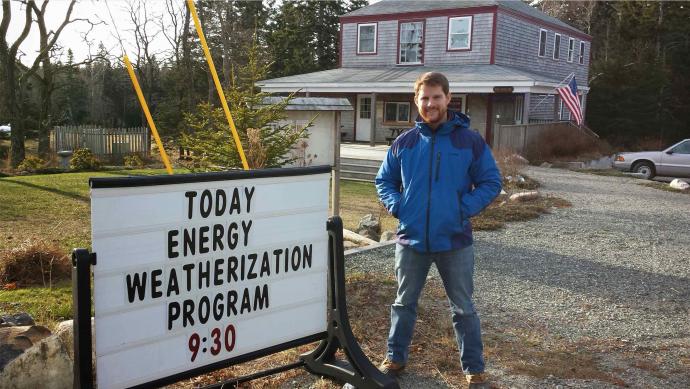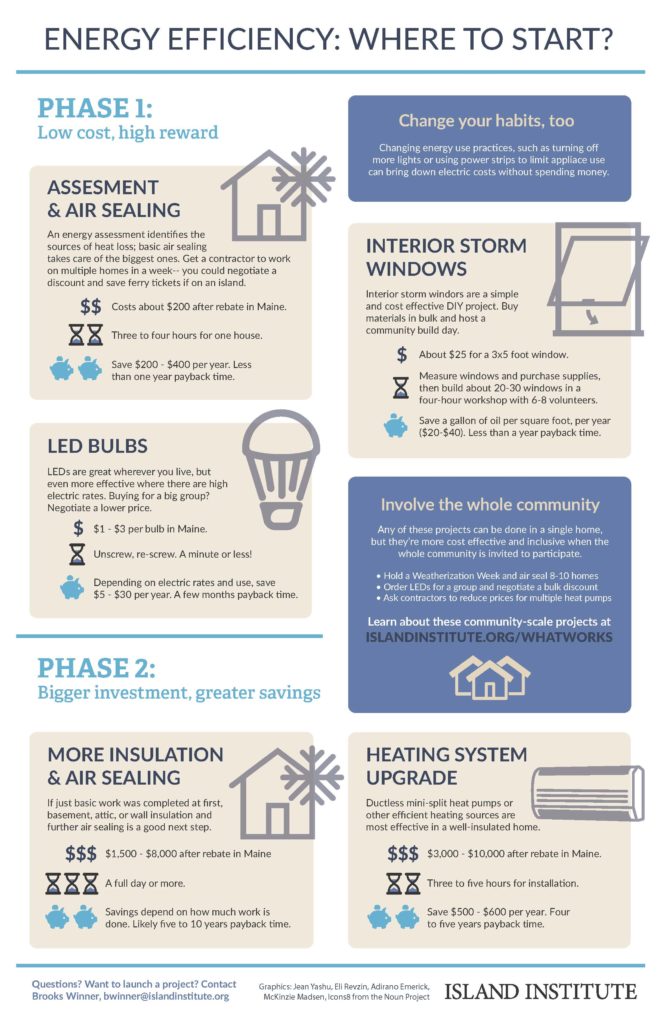Many Maine island homes are old, drafty, and hard to heat during the cold winter. Reducing drafts, improving insulation, and making other small changes can reduce heating bills by hundreds of dollars per year. However, paying for an energy efficiency contractor to make a multi-day trip to weatherize an island or remote coastal home is often prohibitively expensive.
The Island Institute developed a “Weatherization Week” model, which ran from 2013-2017, to make the weatherization of island homes easy and affordable. Community members on several Maine islands have adapted the Weatherization Week model and continue to weatherize homes every year without Island Institute support.
HOW IT BEGAN
The Island Institute energy team started to notice the rural energy efficiency gap through our work with island communities here in Maine. They realized that there were programs for weatherizing homes that were not reaching island communities. When you live on an island or in a rural community, your energy costs are higher but there are also higher barriers to accessing resources for doing energy efficiency work in your home.
To address that, the Island Institute partnered with affordable housing organizations, local energy committees, and municipalities, to coordinate community-scale energy efficiency campaigns. The idea was to work with local partners to get together as many residents – as many homes as possible – and find a contractor willing to go out there to serve that critical mass of customers and do as much work over the course of the week as possible.
HOW IT WORKS
Weatherization Weeks enabled six to ten island homes to receive a professional home energy assessment and basic insulation and air sealing work at a reduced cost over the course of a week. Homeowners paid between $200 and $400 for the home energy assessment (utilizing Efficiency Maine’s Home Energy Savings Program) and six man-hours of insulation and air sealing. While this work would normally cost a homeowner between $700 and $1,000, plus the cost of bringing a certified energy advisor and weatherization supplies to the island, Efficiency Maine covers $400 towards the cost of the work, and the Island Institute helped cover the cost of transportation and housing so that the cost to island participants is at parity with those on the mainland.
If contractors aren’t marketing to your small town, remote village, or island communities, then you’re not going to know about the programs that are available: the rebates and the loans. The Weatherization Weeks model and the idea of community-based energy efficiency addresses that barrier.
The communities that the Island Institute works with have really embraced this idea of doing energy efficiency at scale. Rural communities are very tight knit—people care about their neighbors, and they’re familiar with the idea that if you want to get something done, then strength in numbers is the way to do it.
For example, Monhegan Island is an island of about 50 year-round people, and residents are familiar with the concept of going in together on the cost of a barge to bring vehicles or supplies out. That idea of working together as a community to weatherize homes—to make people warmer and lower energy costs—is something that really resonates in rural places.
IMPLEMENTATION STEPS
- Once several clients were lined up, the coordinator arranged for a certified contractor to travel to the island and stay for several days, grouping all of the work into a short time frame to minimize travel costs to and from a remote location.
- In Maine, Efficiency Maine covered $400 of the cost, and the Island Institute, through the support of its donors, helped provide transportation and housing for the contractor, further reducing the expense to each homeowner.
- Individual homeowners were responsible for paying the contractor for services rendered.
- The community coordinator followed up with the contractor and participating homeowners to gauge interest in a follow trip to perform “next step” upgrades for homeowners that are new to the program. Additional trips were planned—usually 6-18 months after the initial trip.
- Program impact data was collected from the contractor and residents to understand community-level impacts, as well as the experiences of both the customer and the contractor. Adjustments were made to the program when necessary.
Q&A WITH THE ISLAND INSTITUTE
 What was the inspiration for this work and in what ways has it expanded?
What was the inspiration for this work and in what ways has it expanded?
The idea for a group purchase came out of an exchange trip that a couple of islanders took before I was an Island Fellow. They visited Naushon Island near Cape Cod where a lot of work has been done over the past ten years or so to bring down diesel consumption. They started out swapping out the lighting with compact fluorescent, then larger appliances like refrigerators, then did a bunch of work to upgrade their grid and make it more efficient, and finally added renewable generation: solar. They brought down their diesel consumption by around 75% over ten years. The Maine islanders were looking for ways to replicate that on an island that’s not privately owned, because on Naushon they can just go into houses and switch things out. In a community, you can’t just go into people’s houses and rip out their light bulbs, so I surveyed appliances in houses, and found the common needs for energy efficiency improvements. One of the biggest needs was lighting.
What does the Island Institute contribute? What about communities doing this on their own?
We usually cover the cost of transportation and lodging for the week, and any additional charges from the contractor to bring it down to mainland prices. That’s around $700-1000 for a week. It would be easy for a community to just use the incentives available from Efficiency Maine. Folks would have to pay a bit more, but it’s usually manageable. It might pay for itself in 1 1/2 or 2 heating seasons instead of one. If you were doing this in a mainland community in another state that doesn’t have this program, the homeowner would pay $800-1000 for energy assessment and air sealing. That would pay for itself in 2-4 years, which is still pretty good.
What are the roadblocks to getting participants?
People generally think weatherizing their home is expensive, so Weatherization Weeks address that cost barrier by making it affordable to get the energy assessment and air sealing work done, and take that first step. An incremental approach works well on the islands because people get comfortable with making energy upgrades and often follow up by installing new heating systems or insulating their attic or basement. Additionally, what we found is that the contractors of the islands had enough work to keep them busy already. And the training necessary to become certified for Efficiency Maine is expensive and unless you were working across all of the islands, there isn’t a big enough market to justify making that investment.
What’s it like bringing mainland contractors to islands?
When you bring a contractor outside their regular area of service, that comes with logistical complexity. We’ve placed an increasing emphasis on trying to find them good accommodations and make sure they’re squared away with food, maps, and feel supported while they’re there.
Should homeowners be there the whole time?
We recommend that homeowners or renters be there for the whole appointment, 3-4 hours, so that the contractor has access to the basement and attic, but also because it’s an educational opportunity for the homeowner. Contractors can be a really good informational resource and spend time at the beginning and end of the appointment talking about what they see in the house and what they can get to or would recommend addressing after they leave.
What are mistakes you’ve learned from and how are you working to improve?
Having the logistical details all lined up well in advance, and making sure the island coordinator and contractor are on the same page has been challenging in the past, and is really important. It can be tricky or frustrating for the contractor when the coordinator or homeowner isn’t around that week. Recently, we’ve instituted a pretty strict cancellation policy. You submit a deposit and if you have to withdraw less than two weeks before the start of the Weatherization Week you lose your deposit. One thing we’re trying to do better is integrating the Weatherization Week model with other kinds of energy efficiency upgrades. We’re trying to provide the LED bulk purchase or group purchases of heat pumps. We want to show that it starts in one place, by participating in a Weatherization Week, installing interior storm windows, or installing LED bulbs, but that there are lots of opportunities to lower energy bills and make their home more efficient.
How are Weatherization Weeks applicable for mainland communities?
Even if the same barriers of additional cost aren’t there, there is a sense that the community is doing this together, there is visibility that wouldn’t be there if it were just one-off jobs on their own. If you are a grassroots group or a municipal energy committee and you want to weatherize a lot of the homes if your town, having a central coordinator who can help do outreach and scheduling means that you can get a lot of work done over a short period of time with pretty high visibility. Additionally, the bulk discount is appealing, and sharing shipping and disposal costs are a big deal. It’s not fun to get rid of things on an island, so it helps to have one person handle all that.
CHALLENGES
It’s helpful to do the audit and initial weatherization work during the same trip. Recommendations from an audit can easily be dismissed or forgotten if it’s challenging or expensive to bring a contractor back to complete the work.
However, trying to do a huge amount of weatherization work at once is too overwhelming and expensive. Experience has shown that installing insulation and performing low-cost basic air sealing is a comfortable starting place. In our experience, 30% of homeowners have gone on to complete further weatherization after observing results for a winter or two, and local coordination supports a return visit from the contractor.
OUTCOMES
Prior to Weatherization Weeks, only a handful of Maine island homes had participated in Efficiency Maine’s weatherization rebate programs. Since the first Weatherization Week in 2012, more than 400 island homes have participated, collectively saving more than $125,000 per year.
RESOURCES

Originally Published March 2016

